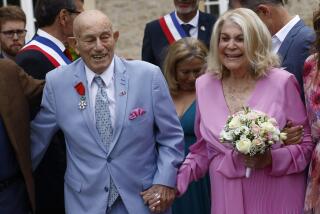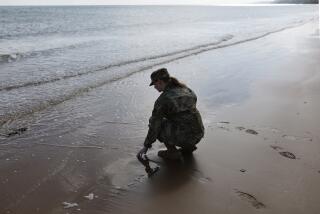Here Come the War Brides : Queen Mary Is Setting for Cruise Down Memory Lane
- Share via
When young Barbara Brisbin of Glasgow, Scotland, sailed to America on the Queen Mary in 1946, she was newly married to an American GI and decidedly apprehensive about her future in a strange new homeland.
“It was scary because it was a whole different way of life, and I didn’t know the reception I’d receive,” recalled Brisbin, 63, with her still-pronounced Scottish burr. “But it’s been smooth sailing ever since.”
This weekend, the smiling Roseburg, Ore., resident is back on the luxury liner-turned-hotel and tourist mecca in Long Beach--one of more than 200 World War II war brides convening to commemorate the 40th anniversary of the end of the war. On deck are women born in England, Germany, Austria, Algeria, Italy--and yes, even a Danish “war groom” who married an American stationed in Munich after the war.
The nationwide gathering, said co-organizer Barbara Scibetta, is the first of its kind and one that is long overdue.
“You reach a stage in your life where you sort of want to look back,” explained Scibetta, 36, herself the daughter of a German-born war bride. “These women seem to need contact with each other at this point in their lives.”
Scibetta, who spent more than a year organizing the “War Brides Revisited” reunion, estimates that as many as one million war brides immigrated to America between 1942 and 1952, including 20,000 on the massive Queen Mary from 1946 to 1948.
Most of the women, she said, easily adjusted to life in the States. But others faced anxious waits of months or years to join their husbands--and once here, were haunted by homesickness, language barriers or narrow-minded resentment, particularly if they had grown up in the vanquished lands, Germany or Japan.
Scibetta’s mother, Else Smith of Victorville, is an extreme case, having been quarantined in a German tuberculosis sanitarium for several years before finally being allowed to immigrate in 1958. Thirteen years later, she separated from her husband. Nonetheless, Smith remains satisfied with her lot, explaining, as she pointed toward Scibetta, “My children have had every type of opportunity here.”
History Book Planned
According to Scibetta, a Pacifica resident who is preparing a history book about war brides, well-known offsprings include San Francisco Giants pitcher Atlee Hammaker, one-time Pittsburgh Steeler running back Franco Harris and pianist Andre Watts.
“And almost all the war brides have become U.S. citizens,” she added.
Saturday afternoon, as the middle-aged women viewed a slide show in the ship’s art deco Grand Salon, they projected an unqualified air of happiness and nostalgia. Indeed, several gave Capt. John Gregory of the Queen Mary a standing ovation when he cheerfully asked whether they were prepared to reaffirm their commitments to their longtime spouses and second homelands for another 40 years.
Among those in the crowd was British native Betty Davis of Poughkeepsie, who embarked on the Queen Mary’s first voyage of war brides in February, 1946.
Davis, who met her husband, George, while on a bicycle ride in Nottingham in 1944, admitted: “I never wanted to come to America--I thought I had to be crazy or madly in love. Forty years later, here I am (at the Queen Mary) again.”
Her husband, who served as a paratrooper and was still recovering from wounds suffered in the Battle of the Bulge when the couple was married in May, 1945, said he was glad to have even seen the Queen Mary once.
After all, George Davis said, “As a paratrooper, I never thought I’d come back from the war at all.”
Met in Refugee Camp
Talvikki Manninen, a Finnish native who now lives in Woodland Hills, recalled meeting her husband-to-be, Norman, while living in a refugee camp in Germany a year after the war ended.
“I had made a Finnish flag that I was wearing and his folks are from Finland . . . and he took care of me like a sister,” she recalled.
When Talvikki Manninen was finally allowed to immigrate, she was told she would be deported if she did not wed within six weeks. She married Norman two weeks after arriving.
Brisbin, whose husband, Wallace, died seven years ago, said her main adjustment living in a tiny Oregon town was to get used to a faster pace of life in a community many times smaller than her birthplace of Glasgow.
Asked what she liked most about the United States, she quickly thought of shopping.
“It’s a nicer experience than in Scotland or England. Most of the time here they’re very pleasant to you, where over there, they are rather indifferent and offhanded. And, oh my gosh, you can’t return things over there.”
More to Read
Sign up for The Wild
We’ll help you find the best places to hike, bike and run, as well as the perfect silent spots for meditation and yoga.
You may occasionally receive promotional content from the Los Angeles Times.






